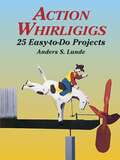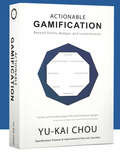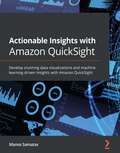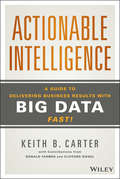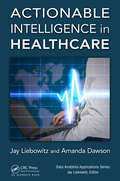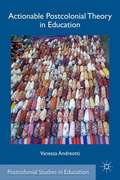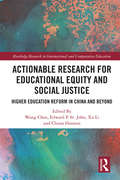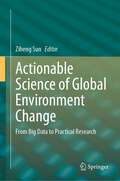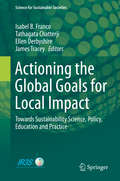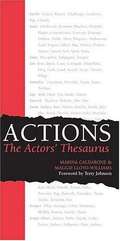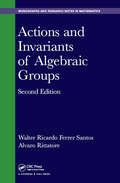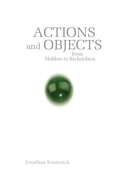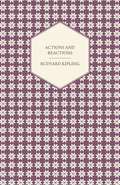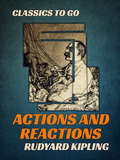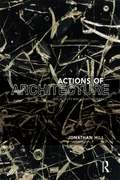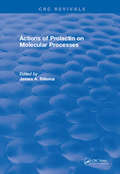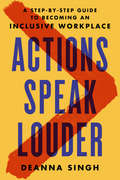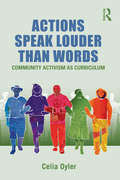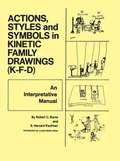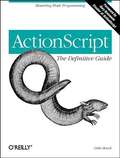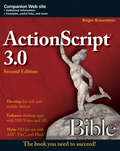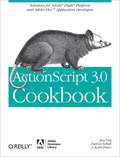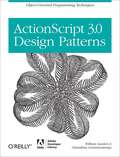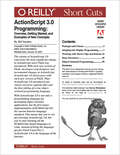- Table View
- List View
Action Whirligigs: 25 Easy-to-Do Projects
by Anders S. LundeWhirligigs -- those charming little wind-driven toys -- make excellent introductory woodworking projects because they are easy to do, inexpensive and -- most of all -- great fun! Hobbyists at all levels of ability will love creating the 25 delightful projects described in this book, from the simple Baking a Pie whirligig to the double-armed Woman at the Computer. Other figures include a Man/Woman Fishing, Oil Well Pump, Saluting the Flag, See-Saw, and Bucking Bronco. Easy-to-follow instructions and measured drawings explain everything from selecting and using proper tools and creating the driving mechanism to finishing and displaying the completed project.
Actionable Gamification: Beyond Points, Badges, and Leaderboards
by Yu-kai ChouLearn all about implementing a good gamification design into your products, workplace, and lifestyle Key Features • Explore what makes a game fun and engaging • Gain insight into the Octalysis Framework and its applications • Discover the potential of the Core Drives of gamification through real-world scenarios Book Description Effective gamification is a combination of game design, game dynamics, user experience, and ROI-driving business implementations. This book explores the interplay between these disciplines and captures the core principles that contribute to a good gamification design. The book starts with an overview of the Octalysis Framework and the 8 Core Drives that can be used to build strategies around the various systems that make games engaging. As the book progresses, each chapter delves deep into a Core Drive, explaining its design and how it should be used. Finally, to apply all the concepts and techniques that you learn throughout, the book contains a brief showcase of using the Octalysis Framework to design a project experience from scratch. After reading this book, you'll have the knowledge and skills to enable the widespread adoption of good gamification and human-focused design in all types of industries. What you will learn • Discover ways to use gamification techniques in real-world situations • Design fun, engaging, and rewarding experiences with Octalysis • Understand what gamification means and how to categorize it • Leverage the power of different Core Drives in your applications • Explore how Left Brain and Right Brain Core Drives differ in motivation and design methodologies • Examine the fascinating intricacies of White Hat and Black Hat Core Drives Who this book is for Anyone who wants to implement gamification principles and techniques into their products, workplace, and lifestyle will find this book useful.
Actionable Insights with Amazon QuickSight: Develop stunning data visualizations and machine learning-driven insights with Amazon QuickSight
by Manos SamatasBuild interactive dashboards and storytelling reports at scale with the cloud-native BI tool - Amazon QuickSight, including embedded analytics and ML-powered insightsKey FeaturesUnderstand how to set up Amazon QuickSight, manage data sources, and build and share dashboardsLearn the advanced features of Amazon Quicksight to develop interactive and embedded dashboardsManage and monitor dashboards using the QuickSight API and other AWS services such as Amazon CloudTrailBook DescriptionThe adoption of cloud-native BI tools, like Amazon QuickSight, enables organizations to gather insights from data at scale. This book is a practical guide to performing simple-to-advanced tasks with Amazon QuickSight.You'll begin by learning QuickSight's fundamental concepts and how to configure data sources. Next, you'll be introduced to the main analysis-building functionality of QuickSight to develop visuals and dashboards. The book will also demonstrate how to develop and share interactive dashboards with parameters and on-screen controls. Advanced filtering options with URL actions will then be covered, before learning how to set up alerts and scheduled reports. Later, you'll explore the Insights visual type in QuickSight using both existing insights and by building custom insights. Further chapters will show you how to add machine learning insights such as forecasting capabilities, analyzing time series data, adding narratives, and outlier detection to your dashboards. You'll also explore patterns to automate operations and look closer into the API actions that allow us to control settings. Finally, you'll learn advanced topics such as embedded dashboards and multitenancy.By the end of this book, you'll be well-versed with QuickSight's BI and analytics functionalities that will help you create BI apps with ML capabilities.What you will learnUnderstand the wider AWS analytics ecosystem and how QuickSight fits within itSet up and configure data sources with Amazon QuickSightInclude custom controls and add interactivity to your BI application using parametersAdd ML insights such as forecasting, anomaly detection, and narrativesExplore patterns to automate operations using QuickSight APIsCreate interactive dashboards and storytelling with Amazon QuickSightDesign an embedded multi-tenant analytics architectureFocus on data permissions and how to manage Amazon QuickSight operationsWho this book is forThis book is for business intelligence (BI) developers and data analysts who are looking to create interactive dashboards using data from Lake House on AWS with Amazon QuickSight. This book will also be useful for anyone who wants to learn Amazon QuickSight in depth using practical examples. You will need to be familiar with general data visualization concepts, however, no prior experience with Amazon QuickSight is required.
Actionable Intelligence
by Keith B. Carter Clifford Siegel Donald FarmerBuilding an analysis ecosystem for a smarter approach tointelligence Keith Carter's Actionable Intelligence: A Guide to DeliveringBusiness Results with Big Data Fast! is the comprehensive guideto achieving the dream that business intelligence practitionershave been chasing since the concept itself came into being. Writtenby an IT visionary with extensive global supply chain experienceand insight, this book describes what happens when team membershave accurate, reliable, usable, and timely information at theirfingertips. With a focus on leveraging big data, the book providesexpert guidance on developing an analytical ecosystem toeffectively manage, use the internal and external information todeliver business results.This book is written by an author who's been in the trenches forpeople who are in the trenches. It's for practitioners in the realworld, who know delivering results is easier said than done -fraught with failure, and difficult politics. A landscape wherereason and passion are needed to make a real difference.This book lays out the appropriate way to establish a culture offact-based decision making, innovation, forward lookingmeasurements, and appropriate high-speed governance. Readers willenable their organization to:Answer strategic questions fasterReduce data acquisition time and increase analysis time toimprove outcomesShift the focus to positive results rather than pastfailuresExpand opportunities by more effectively and thoughtfullyleveraging informationBig data makes big promises, but it cannot deliver without theright recipe of people, processes and technology in place. It'sabout choosing the right people, giving them the right tools, andtaking a thoughtful--rather than formulaic--approach.Actionable Intelligence provides expert guidance towardenvisioning, budgeting, implementing, and delivering realbenefits.
Actionable Intelligence in Healthcare (Data Analytics Applications)
by Amanda Dawson Jay LiebowitzThis book shows healthcare professionals how to turn data points into meaningful knowledge upon which they can take effective action. Actionable intelligence can take many forms, from informing health policymakers on effective strategies for the population to providing direct and predictive insights on patients to healthcare providers so they can achieve positive outcomes. It can assist those performing clinical research where relevant statistical methods are applied to both identify the efficacy of treatments and improve clinical trial design. It also benefits healthcare data standards groups through which pertinent data governance policies are implemented to ensure quality data are obtained, measured, and evaluated for the benefit of all involved. Although the obvious constant thread among all of these important healthcare use cases of actionable intelligence is the data at hand, such data in and of itself merely represents one element of the full structure of healthcare data analytics. This book examines the structure for turning data into actionable knowledge and discusses: The importance of establishing research questions Data collection policies and data governance Principle-centered data analytics to transform data into information Understanding the "why" of classified causes and effects Narratives and visualizations to inform all interested parties Actionable Intelligence in Healthcare is an important examination of how proper healthcare-related questions should be formulated, how relevant data must be transformed to associated information, and how the processing of information relates to knowledge. It indicates to clinicians and researchers why this relative knowledge is meaningful and how best to apply such newfound understanding for the betterment of all.
Actionable Postcolonial Theory in Education
by Vanessa AndreottiAndreotti illustrates how postcolonial theory is applied in the contexts of educational research/critique and in pioneering pedagogical projects. She offers an accessible and useful overview and comparison of theoretical debates related to critiques of Western/Northern hegemony.
Actionable Research for Educational Equity and Social Justice: Higher Education Reform in China and Beyond (Routledge Research in International and Comparative Education)
by Wang Chen Xu Li Edward P. St. John Cliona HannonActionable Research for Educational Equity and Social Justice advances a unique, engaged approach to promoting educational equity and social justice in higher education across China and beyond. Developed as a joint venture of senior and junior scholars in China and the United States, this book documents Chinese, Latin American, U.S., and European examples of engaged scholarship supporting the development of strategies for expanding educational opportunities for low-income families. Drawing from collaborative research, workshops, and field investigations, chapter authors propose and test new methods and practices for reducing educational inequality and provide examples of successful practices that have improved access for low-income students across the globe.
Actionable Science of Global Environment Change: From Big Data to Practical Research
by Ziheng SunThis volume teaches readers how to sort through the vast mountain of climate and environmental science data to extract actionable insights. With the advancements in sensing technology, we now observe petabytes of data related to climate and the environment. While the volume of data is impressive, collecting big data for the sake of data alone proves to be of limited utility. Instead, our quest is for actionable data that can drive tangible actions and meaningful impact.Yet, unearthing actionable insights from the accumulated big data and delivering them to global stakeholders remains a burgeoning field. Although traditional data mining struggles to keep pace with data accumulation, scientific evolution has spurred the emergence of new technologies like numeric modeling and machine learning. These cutting-edge tools are now tackling grand challenges in climate and the environment, from forecasting extreme climate events and enhancing environmental productivity to monitoring greenhouse gas emissions, fostering smart environmental solutions, and understanding aerosols. Additionally, they model environmental-human interactions, inform policy, and steer markets towards a healthier and more environment-friendly direction.While there's no universal solution to address all these formidable tasks, this book takes us on a guided journey through three sections, enriched with chapters from domain scientists. Part I defines actionable science and explores what truly renders data actionable. Part II showcases compelling case studies and practical use scenarios, illustrating these principles in action. Finally, Part III provides an insightful glimpse into the future of actionable science, focusing on the pressing climate and environmental issues we must confront.Embark on this illuminating voyage with us, where big data meets practical research, and discover how our collective efforts move us closer to a sustainable and thriving future. This book is an invitation to unlock the mysteries of our environment, transforming data into decisive action for generations to come.
ActionAid International: Globalizing Governance, Localizing Accountability
by Rachel Gordon Alnoor EbrahimAs a global NGO working in 45 countries, ActionAid International aims to eradicate poverty by addressing its underlying causes such as injustice and inequality. This case follows a series of radical transformations implemented by the organization's CEO, Ramesh Singh--a power shift from its headquarters in London to an international secretariat in Johannesburg; a new federated governance structure that increases the influence of units in Africa and Asia; and, innovations in accountability and transparency to the poor communities with which it works. But as Singh gets ready to step down after seven years, he is confronted with challenges from newly empowered country units that he feels risk taking the organization in the wrong direction. How will the divisions between the Northern and Southern units play out? Will they tear the organization apart, just when it is becoming a global player?
Actioning the Global Goals for Local Impact: Towards Sustainability Science, Policy, Education and Practice (Science for Sustainable Societies)
by Isabel B. Franco Tathagata Chatterji Ellen Derbyshire James TraceyThis book highlights the value of sustainability science in newly emerging and innovative approaches to research, education, capacity building and practice in order to transform rhetoric into impact sustainability. Presenting case studies from various industries, sectors and geographical contexts targeting the seventeen (Sustainable development Goals (SDGs) outlined in the 2030 Agenda, it provides insightful recommendations to create sustainable impact while at the same time achieving the global goals. The book addresses the fundamental question of how sustainability rehtoric can be transformed into impact sustainability research, education and capacity building and as a result, how existing approaches in science, curricula and practice are mitigating the demands emerging from addressing global sustainable development in an impactful and innovative manner. Providing recommendations for impact sustainability in science, curriculum on how to address pressing sustainability issues and contribute toward achieving the SDGs, this book is an essential reference for both academics and professionals.
Actions: The Actors' Thesaurus
by Marina Caldarone Maggie Lloyd-WilliamsThis book is an essential companion for actors in rehearsal - a thesaurus of action words to revitalize performance.
Actions and Invariants of Algebraic Groups (Chapman & Hall/CRC Monographs and Research Notes in Mathematics)
by Walter Ferrer Santos Alvaro RittatoreActions and Invariants of Algebraic Groups, Second Edition presents a self-contained introduction to geometric invariant theory starting from the basic theory of affine algebraic groups and proceeding towards more sophisticated dimensions." Building on the first edition, this book provides an introduction to the theory by equipping the reader with the tools needed to read advanced research in the field. Beginning with commutative algebra, algebraic geometry and the theory of Lie algebras, the book develops the necessary background of affine algebraic groups over an algebraically closed field, and then moves toward the algebraic and geometric aspects of modern invariant theory and quotients.
Actions and Objects from Hobbes to Richardson
by Jonathan KramnickThis work by Kramnick (English, Rutgers U. ) explores ideas about the relationship between mind and action in Restoration and 18th-century British philosophy and literature. He begins the discussion with an overview of the philosophy of action from Thomas Hobbes to David Hume. Thematic chapters then explore the role of consciousness and mental causation in a world of physical laws; the poetry of the Second Earl of Rochester as concerns questions of consciousness, causation, actions, and personhood; the theory of action of John Locke; the fiction of Eliza Haywood and the connection of mental states to the structure of societies; and Samuel Richardson's Clarissa and the mental causation of actions. Annotation ©2011 Book News, Inc. , Portland, OR (booknews. com)
Actions and Reactions
by Rudyard KiplingThis volume contains a collection of short stories written by the seminal English poet and author, Rudyard Kipling. The stories are varied in their themes and range from supernatural tales to science fiction. <P> <P> This wonderful collection is worthy of a place on any bookshelf, and will be of particular value to fans and collectors of Kipling's work. The stories include: An Habitation Enforced, The Recall, Garm A Hostage, The Power of the Dog, The Mother Hive, The Bees and the Flies, With the Night Mail, The Four Angels, A Deal in Cotton, The New Knighthood, and many more. Joseph Rudyard Kipling (1865 - 1936) was a seminal English short-story writer, novelist, and poet. He is most famous for writing many stories and poems concerning British soldiers in India. Many vintage texts such as this are increasingly scarce and expensive, and it is with this in mind that we are republishing this book now, in an affordable, high-quality, modern edition. It comes complete with a specially commissioned biography of the author. "
Actions and Reactions (Classics To Go)
by Rudyard KiplingA selection of short stories by Kipling, along with a poem loosely related to each story. (Excerpt from Goodreads)
Actions of Architecture: Architects and Creative Users
by Jonathan HillDrawing on the work of a wide range of architects, artists and writers, this book considers the relations between the architect and the user, which it compares to the relations between the artist and viewer and the author and reader. The book's thesis is informed by the text 'The Death of the Author', in which Roland Barthes argues for a writer aware of the creativity of the reader. Actions of Architecture begins with a critique of strategies that define the user as passive and predictable, such as contemplation and functionalism. Subsequently it considers how an awareness of user creativity informs architecture, architects and concepts of authorship in architectural design. Identifying strategies that recognize user creativity, such as appropriation, collaboration, disjunction, DIY, montage, polyvalence and uselessness, Actions of Architecture states that the creative user should be the central concern of architectural design.
Actions of Prolactin On Molecular Processes
by James A. RillemaIt is well established tht the intial interaction of prolactin with its target cells is with specific receptor molecules located on the external surface of the plasma membrane. Subsequent to the prolactin-receptor interaction, however, the molecular events that culminate in the regulation of biological processes are not totally understood. This book was assembled to review and analyse the currently available information relative to the molecular events involved in the actions of prolactin on cells. Hopefully, the assimilation of this information will provide the basis for ultimately determining the sequence of molecular reactions by which prolactin expresses its biological responses.
Actions Speak Louder: A Step-by-Step Guide to Becoming an Inclusive Workplace
by Deanna Singh"A timely, practical resource on creating teams and organizations where everyone has the opportunity to succeed."--Adam Grant, #1 New York Times bestselling author of Think Again and host of the podcast WorkLife A step-by-step guide for managers, teams, and DEI leaders looking to create impactful, lasting change in their organization, from recruitment to retention, and beyond. Are you tired of hollow promises about diversity, equity, and inclusion in your organization? Do you want to take steps towards real change – beyond issuing mission statements, signing checks, and holding listening sessions – but don&’t know where to start? This book is your answer. Designed for teams to read together, Actions Speak Louder offers a comprehensive blueprint for leaders and teams who are ready to get out of their own way, look at their surroundings with new eyes, and turn their energy into a concrete plan. Renowned DEI consultant Deanna Singh has led diversity trainings for a wide range of organizations, from non-profits to Fortune 500 companies. Using narratives, case studies, and the latest DEI research, as well as interactive exercises, Singh will teach you how to: • Write inclusive job advertisements because &“minorities just don&’t apply here&” isn&’t an excuse – you&’re just not reaching them • Design an interview process that reduces status quo bias and challenges hiring decisions that are simply &“no brainers&” • Create a retention plan that considers and prioritizes the needs of underrepresented employees – if you haven&’t intentionally designed one to be inclusive, you&’ve unintentionally reinforced one that is exclusive. • Lead inclusive meetings – the bedrock of company culture – by practicing constructive dissent and elevating underrepresented perspectives As Singh has seen time and time again, any organization can meaningfully change – you just need the right tools.
Actions Speak Louder than Words: Community Activism as Curriculum (Teaching/Learning Social Justice)
by Celia OylerHow do educators engage students in community action projects without telling them what to think, how to think, or what to do? Is it possible to integrate social justice organizing into the curriculum without imposing one’s political views on students? In Actions Speak Louder than Words, longtime activist and teacher educator Celia Oyler delves into such questions through firsthand accounts of social action projects. By moving beyond charity work or volunteerism, she shows how community activism projects offer fertile ground for practicing democratic engagement as part of classroom work. Actions Speak Louder than Words is a systematic, qualitative study offering in-depth and detailed portraits of teachers who design social action projects as part of the regular classroom curriculum. Each case forms a chapter organized as a narrative that includes excerpts from classroom dialogues, and interviews with students, teachers, and parents describing their social action projects with sufficient detail to give educators guidance for designing such projects for their own classrooms. The final chapter examines power, pedagogy, and learning outcomes across the cases, providing specific guidance to educators wishing to take up such projects and offering instructional and procedural advice as well as cautions. A fresh new example of taking up the challenge to teach toward equity and social justice, Actions Speak Louder than Words is an invaluable resource for educators who are passionate about the possibility of integrating activism and advocacy into curriculum as a means to engage in strong democracy.
Actions, Styles, and Symbols in Kinetic Family Drawings (K-F-D): An Interpretative Manual
by Robert C. Burns S. Harvard KaufmanThis classic text focuses on the features of K-F-D that have emerged after more than 12 years of clinical experience with 10,000 drawings. One-hundred and thirty drawings are reproduced, showing common characteristics of K-F-D figures and the varied actions and symbols that reflect relations between family members. Included are a K-F-D Grid and an Analysis Sheet to assist clinicians in interpreting their own patients' K-F-Ds.
ActionScript: The Definitive Guide
by Colin MoockGiven its ability to deliver high-impact experiences even over low-bandwidth connections, Flash has become the de facto standard for hundreds of thousands of multimedia web developers worldwide. Flash 5 now includes a new full-fledged programming language called "ActionScript" for controlling animation and multimedia. It's a quantum leap from the bare-bones "Actions" supported in Flash 4, and ActionScript: The Definitive Guide is the first book dedicated entirely to documenting and demonstrating this new language. ActionScript includes all fundamental programming constructs (variables, loops, conditionals, functions, etc.), and is inextricably fused with Flash's authoring behaviors and animation timelines. Because ActionScript is based heavily on the ECMAScript Language Specification (ECMA-262) and is syntactically nearly identical to JavaScript, Macromedia expects thousands of existing JavaScript programmers to migrate to ActionScript. This book is divided into three sections. "ActionScript Fundamentals" introduces both programmers and non-programmers to the new language by first describing fundamental programming concepts and then delineating in detail the components, syntax, and usage of ActionScript. "Applied ActionScript Code Depot" shows you how to use common applications, such as processing online forms. "Language Reference" is a concise and detailed reference that makes all ActionScript globals, properties, and objects, including extensive implementation samples, easy to find quickly. Step-by-step tutorials of the most common ActionScript behaviors Object-oriented programming in Flash Intelligent interface development Server communication Dynamic content generation Password protection String handling Message boards Basic physics Games Code samples are also available from the "Code Depot" on the author's web site devoted to Flash developers. Topics covered in this book include: ActionScript: The Definitive Guide is structured so both programmers and non-programmers can learn how to use ActionScript. This book will take you well beyond simple Flash animations so you can create your own enhanced Flash-driven sites.
ActionScript 3.0 Bible (Bible #617)
by Roger BraunsteinThe updated edition on all the latest features and capabilities of ActionScript 3.0 and Flash Player 10. ActionScript is a popular programming language used primarily for the development of Web sites and software. This update to the successful previous version introduces you to all the exciting new capabilities of ActionScript 3.0. You'll see how ActionScript 3.0 goes beyond its primary use of scripting Flash animations and is now an object-oriented evolution that runs ten times faster than previous versions and can be used in Adobe's new platforms, including Flex and AIR. Hands-on instruction and step-by-step tutorials enhance your learning process as you discover everything you need to know in order to harness the power of ActionScript 3.0. You'll learn the nitty gritty of building Rich Internet Applications (RIA) and the ins and outs of putting the new features of ActionScript 3.0 to work for you. ActionScript 3.0 goes beyond its original role as a scripting language and has added development features, incredible speed, and the ability to work with Flex and AIR Shows you how to apply advanced graphic effects using Pixel Blender Demonstrates the all-new text and typography capabilities Addresses your new enhanced control over dynamic sound Explains templated types and new vector data structures ActionScript 3.0 Bible offers you a soup-to-nuts guide on all things ActionScript 3.0 so you can get started working with it immediately.
ActionScript 3.0 Cookbook: Solutions for Flash Platform and Flex Application Developers
by Joey Lott Darron Schall Keith PetersWell before Ajax and Microsoft's Windows Presentation Foundation hit the scene, Macromedia offered the first method for building web pages with the responsiveness and functionality of desktop programs with its Flash-based "Rich Internet Applications". Now, new owner Adobe is taking Flash and its powerful capabilities beyond the Web and making it a full-fledged development environment.Rather than focus on theory, the ActionScript 3.0 Cookbook concentrates on the practical application of ActionScript, with more than 300 solutions you can use to solve a wide range of common coding dilemmas. You'll find recipes that show you how to:Detect the user's Flash Player version or their operating systemBuild custom classesFormat dates and currency typesWork with stringsBuild user interface componentsWork with audio and videoMake remote procedure calls using Flash Remoting and web servicesLoad, send, and search XML dataAnd much, much more ...Each code recipe presents the Problem, Solution, and Discussion of how you can use it in other ways or personalize it for your own needs, and why it works. You can quickly locate the recipe that most closely matches your situation and get the solution without reading the whole book to understand the underlying code. Solutions progress from short recipes for small problems to more complex scripts for thornier riddles, and the discussions offer a deeper analysis for resolving similar issues in the future, along with possible design choices and ramifications. You'll even learn how to link modular ActionScript pieces together to create rock-solid solutions for Flex 2 and Flash applications.When you're not sure how ActionScript 3.0 works or how to approach a specific programming dilemma, you can simply pick up the book, flip to the relevant recipe(s), and quickly find the solution you're looking for.Adobe Developer Library is a co-publishing partnership between O'Reilly Media and Adobe Systems, Inc. and is designed to produce the number one information resources for developers who use Adobe technologies. Created in 2006, the Adobe Developer Library is the official source for comprehensive learning solutions to help developers create expressive and interactive web applications that can reach virtually anyone on any platform. With top-notch books and innovative online resources covering the latest in rich Internet application development, the Adobe Developer Library offers expert training and in-depth resources, straight from the source.
ActionScript 3.0 Design Patterns
by William Sanders Chandima CumaranatungeNow that ActionScript is reengineered from top to bottom as a true object-oriented programming (OOP) language, reusable design patterns are an ideal way to solve common problems in Flash and Flex applications. If you're an experienced Flash or Flex developer ready to tackle sophisticated programming techniques with ActionScript 3.0, this hands-on introduction to design patterns is the book you need.ActionScript 3.0 Design Patterns takes you step by step through the process, first by explaining how design patterns provide a clear road map for structuring code that actually makes OOP languages easier to learn and use. You then learn about various types of design patterns and construct small abstract examples before trying your hand at building full-fledged working applications outlined in the book. Topics in ActionScript 3.0 Design Patterns include: Key features of ActionScript 3.0 and why it became an OOP language OOP characteristics, such as classes, abstraction, inheritance, and polymorphism The benefits of using design patterns Creational patterns, including Factory and Singleton patterns Structural patterns, including Decorator, Adapter, and Composite patterns Behavioral patterns, including Command, Observer, Strategy, and State patterns Multiple design patterns, including Model-View-Controller and Symmetric Proxy designs During the course of the book, you'll work with examples of increasing complexity, such as an e-business application with service options that users can select, an interface for selecting a class of products and individual products in each class, an action game application, a video record and playback application, and many more. Whether you're coming to Flash and Flex from Java or C++, or have experience with ActionScript 2.0, ActionScript 3.0 Design Patterns will have you constructing truly elegant solutions for your Flash and Flex applications in no time.
ActionScript 3.0 Programming: Overview, Getting Started, and Examples of New Concepts
by William SandersActionScript 3.0 Programming: Overview, Getting Started, and Examples of New Concepts is a 76-page document designed to introduce those familiar with general programming principles to ActionScript 3.0. ActionScript 3.0 compiles and runs much faster than preceding versions, and the reasons have much to do with the structural changes Adobe has added: You truly do need to use ActionScript differently than you have previously, if you're already ActionScript programmer. If you're new to ActionScript, but are looking at it from a Java or C++ or C# perspective, you may be intrigued at how different ActionScript is now compared with what you'd known it or heard it to be before.This document employs reusable code examples to demonstrate the basic functionality of ActionScript 3.0 in the following topic areas: Packages and Classes; Display Programming; Movie Clips and Buttons; and Basic Structures. A concluding section helps those unfamiliar with OOP (Object Oriented Programming) and Design Patterns get acquainted with these concepts, as a knowledge of them will greatly benefit anyone getting into ActionScript 3.0 who wants to get the most out of it.
